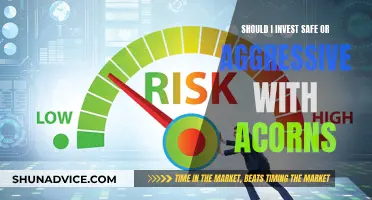
Investment risk changes over an individual's life cycle due to shifting financial needs and goals. A person's risk tolerance, investment horizon, and financial objectives all evolve as they progress through life stages, from early career to retirement. Life-cycle investing recognises this dynamic nature of investment risk and provides a framework for tailoring investment strategies accordingly. As individuals age, their investment horizon typically shortens, and their willingness to take on risk may decrease. This often translates to a gradual shift from higher-risk investments, such as equities, to lower-risk options, such as bonds and cash equivalents, as retirement approaches.
| Characteristics | Values |
|---|---|
| Risk Profile | Changes over time, influenced by age, financial goals, and life events |
| Risk Tolerance | Generally decreases with age and increased financial commitments |
| Investment Horizon | Shortens with age, impacting asset allocation and risk appetite |
| Financial Goals | Vary with life stages, from short-term goals like buying a car to long-term retirement planning |
| Asset Allocation | Should evolve over time to reflect changing risk tolerance and goals; typically shifts from stocks to bonds with age |
| Investment Strategies | Target-date funds, glide path strategies, and dynamic asset allocation help adjust asset allocation over time |
| Risk Management | Diversification, rebalancing, hedging, and periodic risk tolerance assessments are key strategies to manage risk |
| Retirement Planning | Includes employer-sponsored plans, individual retirement accounts (IRAs), and other savings vehicles |
What You'll Learn

Risk tolerance and age
During the early career stage, individuals often focus on building their careers and saving for short-term goals. At this stage, they may have a higher risk tolerance due to having more years to recover from potential losses and less financial commitments. As a result, they may allocate a larger proportion of their portfolio to higher-risk assets.
In the mid-career stage, individuals often start to accumulate wealth, save for their children's education, and invest in real estate. While their risk appetite may still be moderately high, they also have higher responsibilities and financial commitments, such as mortgages and children's expenses. Therefore, their investment strategy may start to shift towards a more balanced approach, including both higher- and lower-risk assets.
The late career stage is typically characterised by maximising retirement savings, paying off debts, and planning for a secure financial future. At this stage, individuals may have less time to recover from potential losses and may be more risk-averse. As a result, they often reduce their exposure to higher-risk investments and increase their allocation to lower-risk options.
Retirement is the final stage, where individuals focus on generating a steady income stream, preserving their wealth, and managing their assets to last throughout their retirement years. During this stage, risk tolerance is generally lower, and individuals seek stable and liquid investments that provide a reliable income.
It is important to note that while age is a significant factor in determining risk tolerance, it is not the only consideration. Other factors, such as financial goals, investment horizon, and personal circumstances, also play a crucial role in shaping an individual's investment strategy. Regularly reviewing and adjusting investment portfolios to align with changing needs and circumstances is essential for successful long-term financial planning.
Equity Investments: Halal or Haram?
You may want to see also

Investment horizon
Short-term investment horizon
This type of investment time frame is best for individuals in their later years, preparing for retirement. It is also suitable for those who are strongly averse to risk or need access to a large sum of money in the near future. A short investment horizon usually doesn't exceed three years. For these risk-averse investors, it is advisable to have guaranteed assets or securities, such as high-interest savings accounts and certificates of deposit.
Medium-term investment horizon
Investors who are less risk-averse and not looking for cash for retirement or a large purchase are better suited to a medium-term investment horizon. This usually means a period of three to ten years. Investors with this type of investment horizon are somewhere in the middle between low and high risk, meaning a conservative and diversified portfolio is best, mixing investments in both stocks and bonds. The ratio of stocks to bonds should be determined by the individual's specific wants and needs.
Long-term investment horizon
Long-term investment horizons are for investors willing to take big risks for big rewards and who have the time to wait for the payoff or to recoup losses after risky endeavours. In most cases, the portfolio of a long-term investor includes a significant amount of risky investments with potentially high yields. The remainder of the portfolio should then be a mix of stocks and bonds, with the ratio leaning more heavily towards stocks.
Adjusting the investment horizon
It is important to note that an individual's horizon can evolve over time as their financial goals and circumstances change. Therefore, it is advisable to periodically reassess and adjust investment strategies accordingly. As an investor's horizon shortens, they typically adjust their portfolio to reduce its level of risk. For example, most retirement portfolios decrease their exposure to equities and increase their holdings of fixed-income assets as they near retirement.
Factors That Encourage Investors to Invest Money
You may want to see also

Financial goals
- During the early career stage, individuals often focus on building their careers, repaying student loans, and saving for short-term goals like buying a car or starting a family. Their investment strategies at this stage may involve prioritising liquidity and lower-risk assets to preserve capital and generate steady income.
- In the mid-career stage, individuals typically shift their focus to wealth accumulation, saving for their children's education, and investing in real estate. During this phase, they may take on more risk in their investment portfolios, including equities and alternative investments, to pursue higher returns.
- As individuals approach the late career stage, maximising retirement savings, clearing debts, and planning for a financially secure retirement become priorities. Their investment strategies tend to involve reducing risk exposure by shifting from higher-risk assets, such as equities, to lower-risk investments like bonds and cash equivalents. This helps preserve capital and minimise the impact of potential market downturns as retirement nears.
- During the retirement stage, the focus shifts to generating a consistent income stream, preserving wealth, and managing assets to ensure they last throughout retirement. Strategies at this stage may include withdrawal plans, annuities, and social security benefits.
- Life-cycle investing also recognises that financial goals can be influenced by life events such as marriage, divorce, job loss, or childbirth. Adjusting investment strategies in response to these changes is crucial for staying on track with long-term financial objectives.
By regularly reviewing and adjusting investment portfolios to align with their financial goals, individuals can increase their chances of achieving those goals and enjoying financial security throughout their lives.
How Much Cash Should You Hold in Your Investment Portfolio?
You may want to see also

Asset allocation
Early Career Stage:
During the early career stage, individuals often focus on building their careers, paying off student loans, and saving for short-term goals. At this stage, individuals may have a higher risk appetite due to their longer investment horizon and willingness to take risks. As a result, they may allocate a larger portion of their portfolio to equities, which offer capital appreciation and potential dividend income.
Mid-Career Stage:
In the mid-career stage, individuals typically concentrate on wealth accumulation, saving for their children's education, and investing in real estate. While they may still maintain a moderate risk appetite, they start considering more diversified portfolios. This may include fixed-income securities, such as bonds, which provide a steady income stream and help preserve capital.
Late Career Stage:
As individuals approach the late career stage, their investment horizon shortens, and they prioritize maximizing retirement savings and paying off debts. At this stage, risk tolerance usually decreases, and individuals may shift their asset allocation towards lower-risk investments. Target-date funds become particularly relevant, gradually moving from higher-risk equities to lower-risk bonds and cash equivalents.
Retirement Stage:
During the retirement stage, the focus shifts to generating a steady income stream and preserving wealth. While individuals still need to consider market and inflation risks, they may further adjust their asset allocation to include more stable and liquid investments. This could mean an increased focus on cash and cash equivalents, such as money market funds or short-term certificates of deposit (CDs).
It is important to note that while these are general trends, each individual's circumstances are unique. Factors such as financial goals, risk tolerance, and market conditions will influence their specific asset allocation decisions. Regular reviews and adjustments to the investment portfolio are crucial to ensure it remains aligned with their life stage and risk profile.
Warren Buffett's Private Equity Investment Strategy Explored
You may want to see also

Strategies for managing risk
As an individual's risk tolerance changes over time, it is important to employ strategies that ensure their investment portfolio remains aligned with their evolving needs and circumstances. Here are some strategies for managing investment risk throughout an individual's life cycle:
Diversification
Diversifying one's investment portfolio across a range of asset classes, sectors, and geographic regions can help reduce the overall risk. By spreading investments, the impact of any single investment on the portfolio's performance is minimised. This strategy also provides exposure to different types of investments, allowing for a more balanced approach.
Rebalancing
Regularly reviewing and adjusting the asset allocation within a portfolio is essential to maintaining the desired level of risk and return. Over time, certain investments may outperform others, causing an imbalance in the portfolio. By rebalancing, investors can ensure their portfolio remains aligned with their risk tolerance and financial goals.
Hedging
Hedging techniques, such as using options or futures contracts, can be employed to protect the portfolio against specific risks or market downturns. These strategies act as a form of insurance, providing a safeguard against potential losses.
Risk Tolerance Adjustments
Periodically reassessing and adjusting one's risk tolerance is crucial to ensuring the investment portfolio remains suitable for the individual's changing circumstances. As life progresses, factors such as age, financial commitments, and life events can impact an individual's risk appetite. Therefore, regular reviews help keep the portfolio aligned with their evolving risk tolerance.
Glide Path Strategies
Glide path strategies involve adjusting the asset allocation as an investor ages, generally by reducing the proportion of higher-risk assets and increasing lower-risk assets. This approach helps balance risk and return throughout an individual's life cycle, ensuring that risk exposure is appropriate for their current life stage.
Dynamic Asset Allocation
Dynamic asset allocation is a flexible strategy that involves regularly reviewing and adjusting the investor's asset allocation based on market conditions, investment performance, and personal circumstances. This approach allows the portfolio to adapt to changing situations, helping investors stay on track with their long-term financial goals.
Investing in Apollo Global Management: A Comprehensive Guide
You may want to see also
Frequently asked questions
Life-cycle investing is a financial planning approach that involves adjusting investment portfolios to align with an individual's changing financial needs and goals as they progress through different life stages. These stages typically include early career, mid-career, late career, and retirement, each associated with different investment priorities and risk tolerances.
Life-cycle investing strategies focus on balancing risk and return to achieve long-term financial objectives. As individuals age, their investment horizon typically shortens, and their risk tolerance may decrease. Therefore, life-cycle investing often involves adjusting asset allocation over time, shifting from higher-risk investments, such as equities, to lower-risk investments, like bonds and cash equivalents. This adjustment can be done using target-date funds, glide path strategies, or dynamic asset allocation.
Life-cycle investing offers a comprehensive framework for making informed financial decisions by considering factors such as age, risk tolerance, and investment horizon. It helps individuals manage their finances effectively, enabling them to achieve their financial goals and maintain financial stability throughout their lives. Additionally, life-cycle investing can assist in reducing overall investment risk and ensuring that portfolios remain aligned with changing needs and circumstances.







